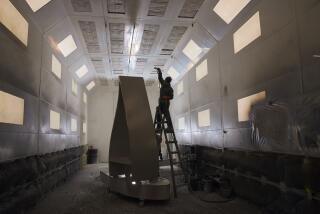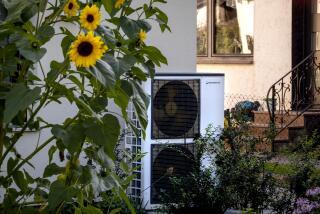Tracking Down Wasted Energy
- Share via
At the sensor factory, Steve Vasquez sensed money being wasted.
He saw ceiling lamps hanging over electro-optical assembly tables that were already brightly lit by their own built-in fixtures.
He felt heat from empty ovens still switched on, even though the silicon wafer microchips that earlier baked there had long ago been removed.
He heard the rumble of an ancient air conditioner that was sucking about twice as much electric current as modern cooling systems do.
Vasquez, 20, didn’t need an electronic detector to uncover the squandered energy. He’s part of a new team of college students from Los Angeles that has been specially trained to sniff out wasteful practices at manufacturing plants.
It’s a free service for companies--the federal Department of Energy pays the cost of the Loyola Marymount University program. And as the California energy crisis continues, it’s starting to pay off big-time for small businesses.
The Loyola Marymount students calculate that they have saved seven firms a total of $2.2 million so far this year. That figure is likely to more than double when the savings for another 10 recently inspected companies are added up.
Besides monitoring electricity usage, the students from the Westchester campus look for productivity and waste-disposal problems when they show up armed with clipboards and youthful curiosity.
Program Involves 26 Universities
The inspection service is coordinated by a Philadelphia-based nonprofit group called Industrial Technology and Energy Management. Twenty-six universities across the country participate, including San Diego State and San Francisco State.
Loyola Marymount joined the program earlier this year. Eighteen engineering students--all but one of whom are undergraduates--are taking part. They receive class credit and $204 for each inspection, with rotating team leaders getting $916.
The Department of Energy pays $6,100 to cover the cost of each company assessment. In return, inspection teams are required to find at least that much in energy or resource savings.
Officials say the typical inspection nationwide results in recommendations that can save a company more than $55,000 a year.
With that in mind, factory owners are more than happy to give students complete access to production areas as well as to plant managers and workers. Companies, which are promised confidentiality, receive written recommendations from the students within two months.
Professor Focuses on Decreasing Waste
The sensor manufacturing plant--whose operators requested its name not be used--is located in a Hawthorne industrial park. There, Vasquez was joined by students Andre Ingistov and Pablo Padilla, Loyola Marymount mechanical engineering professor Bohdan “Bo” Oppenheim and engineering lecturer Rudolf Marloth.
Oppenheim, a productivity expert, has taught at Loyola Marymount for 20 years. He utilizes a curriculum, spun off from Toyota Co.’s “lean” manufacturing concept, that teaches how to identify and fix wasted productivity and resources.
The group was given white coats and paper head coverings to wear in the various “clean rooms” in the sprawling, one-story plant. Vasquez, a junior from Brawley, was in charge of the day’s inspection.
The team’s attention was quickly drawn to the bank of TV-size electric ovens used in a curing process for silicon wafers. They form part of the photodiodes in sensor systems ranging from supermarket bar-code readers to astronauts’ space suit controls.
Manager Vijay Patel explained that the ovens remain on 24 hours a day during the workweek, even when they’re empty. That’s because it takes half an hour to warm them up in the morning and because of concerns that electric heating elements will become brittle if they are repeatedly turned off and on.
The students jotted down the ovens’ serial numbers and promised to check with the manufacturer about the threat of brittleness. Oppenheim said that the ovens’ vendor might be able to supply more modern heating elements that could solve the problem.
“Turning this stuff off at night and paying a guy an incentive to come in 30 minutes early in the morning to turn them on will pay for itself very quickly in energy savings,” Vasquez said.
Other suggestions included installing skylights and using new bulbs and reflectors on fluorescent ceiling lights to cut electricity use.
Before leaving, the students made note of the inefficient air conditioner and of costly leaks in air compressor lines. They also paid close attention to the plant’s operation schedule and to its Southern California Edison Co. bill.
“If they’re willing to set up a 4 a.m.-to-noon work schedule, there are huge savings. Rates are umpteen times higher during high-demand times, between noon and 6 p.m.,” Marloth said.
The sensor plant also could save production costs by changing its quality inspection procedure and speeding the flow of materials from the loading dock to the assembly table, the students found.
It will be August before the Hawthorne sensor plant recommendations are written and the amount of potential savings is known. But possible annual savings of more than $1 million were found at a Covina manufacturing plant that students visited during the spring, Oppenheim said.
Robin Steffens, a contracts manager for a Hawthorne airport equipment company inspected earlier this year by a different Loyola Marymount team, said his firm found savings of $21,000 a year by merely moving a screw bin closer to an assembly work bench as students suggested. The young inspectors had noticed that workers were wasting time walking back and forth.
Other recommendations could save millions of dollars in future years, he said. The students proposed upgrading equipment to save electric costs, pointing out that energy conservation tax credits will help pay for the investment. “Sometimes you can’t see the forest for the trees when you’re in it,” Steffens said, praising the students.
Officials of the Industrial Technology and Energy Management coordinating group say about 9,000 student inspections have been conducted since the program started 25 years ago. Manufacturers have saved an estimated $400 million as a result.
To qualify for the free inspections, companies must have gross sales below $100 million, 500 or fewer employees, and annual utility bills between $100,000 and $2 million.
“In the early days, one of the most difficult tasks was finding clients to serve,” said William Clark, who oversees the program for schools in the Western United States. But the energy crisis changed that. “Clients now are calling for assessments.”
Student Puts Ideas to Use in His Company
The students say they come away from their inspections with plenty of ideas to use in their own careers. Most, like Vasquez, hope to eventually own their own manufacturing companies.
Ingistov already does. He said he recently became co-owner of a pizza restaurant in Westchester, and he wasted no time in putting to use what he has learned from the inspections.
“We got rid of all but the fluorescent lights, and we keep the oven doors closed more often than they used to be,” he said. “And I’ve set up an assembly line-like thing with the pizzas, moving all the condiments together. The previous owner had everything in a refrigerator in the back. You had to keep walking back and forth for anchovies and pineapple.”
Inefficiency is senseless, Ingistov said, whether you’re making photometric sensors or pepperoni pizzas.
More to Read
Inside the business of entertainment
The Wide Shot brings you news, analysis and insights on everything from streaming wars to production — and what it all means for the future.
You may occasionally receive promotional content from the Los Angeles Times.











